Using Pallets to Stabilize a Garden Slope
Let’s face it, gardening on a slope can be a challenge. You picture rows of thriving vegetables and colorful flowers, but instead, you’re constantly battling erosion and soil washout. Raised beds seem like a dream, and frustration becomes your best friend.
But hold on! A sloped garden doesn’t have to be a lost cause. In fact, stabilizing or leveling a garden slope can be opportunity to create something special. The best part? You can achieve that beautiful garden you’ve envisioned without spending a fortune or harming the environment.
There are many ways to level a garden slope. One answer lies in a surprising direction: recycled pallets. These readily available materials can transform your slope from an eyesore into a thriving, functional garden. So, grab a drink, ditch the shovel for a minute, and let’s explore the world of slope stabilization with pallets. We’ll cover everything you need to know to build beautiful and eco-friendly garden structures that will have your neighbors asking, “Seriously, you can do that with pallets?”
Pallet Selection and Preparation: Building a Safe and Sturdy Foundation
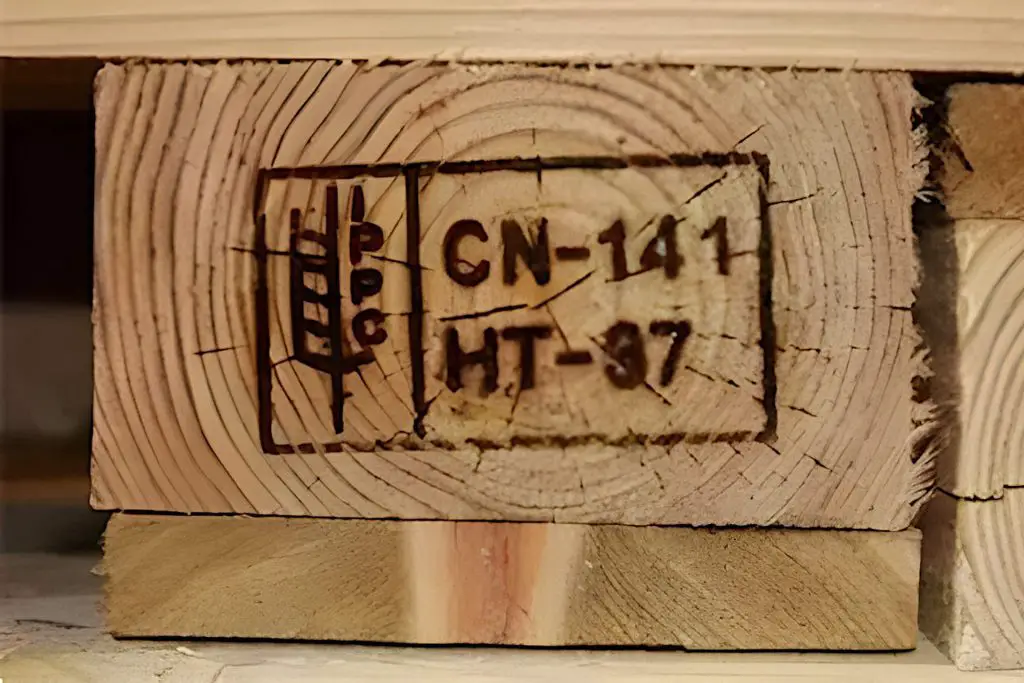
Selecting the right type of pallet is crucial for garden projects, especially when stabilizing slopes. Heat-treated (HT) pallets are the most suitable choice because they’re free from harmful chemicals. These pallets bear the “HT” stamp, indicating they’ve been treated with heat rather than chemicals, making them safe for use around plants and vegetables.
When sourcing pallets, look for those marked with the International Plant Protection Convention (IPPC) logo, which guarantees that the pallet meets international shipping standards and is free from pests. Avoid pallets treated with methyl bromide (marked with “MB”), a toxic chemical harmful to both humans and the environment.
It’s also important to inspect pallets for any signs of contamination. Pallets stained with unknown substances could carry risks, potentially contaminating your soil. Opt for pallets that appear clean and dry without any foul odors or residue.
Making Sure the Pallets Are Clean and Undamaged
Once you’ve identified pallets HT-stamped, give them a good inspection. It’s also important to inspect pallets for any signs of contamination. Pallets stained with unknown substances could carry risks, potentially contaminating your soil. Opt for pallets that appear clean and dry without any foul odors or residue.
In addition it is wise to avoid pallets with obvious signs of damage. Give them a scrub with soap and water to remove any dirt or debris, and consider sanding down rough edges for a smoother finish.
Disassembly: A DIY Decision:
Depending on your project, you may choose to keep your pallets intact or disassemble them into individual boards. This will require some elbow grease and the right tools, such as a crowbar and hammer. Disassembling allows for greater design flexibility but also takes more time and effort.
Lifespan
A final consideration is the lifespan of the pallets. While heat-treated wood is not designed to last forever, it should serve well for five to ten years, depending on the climate and how well it’s maintained. This period allows for significant root growth and soil stabilization by plants before the pallets begin to degrade naturally.
Designing the Pallet Layout
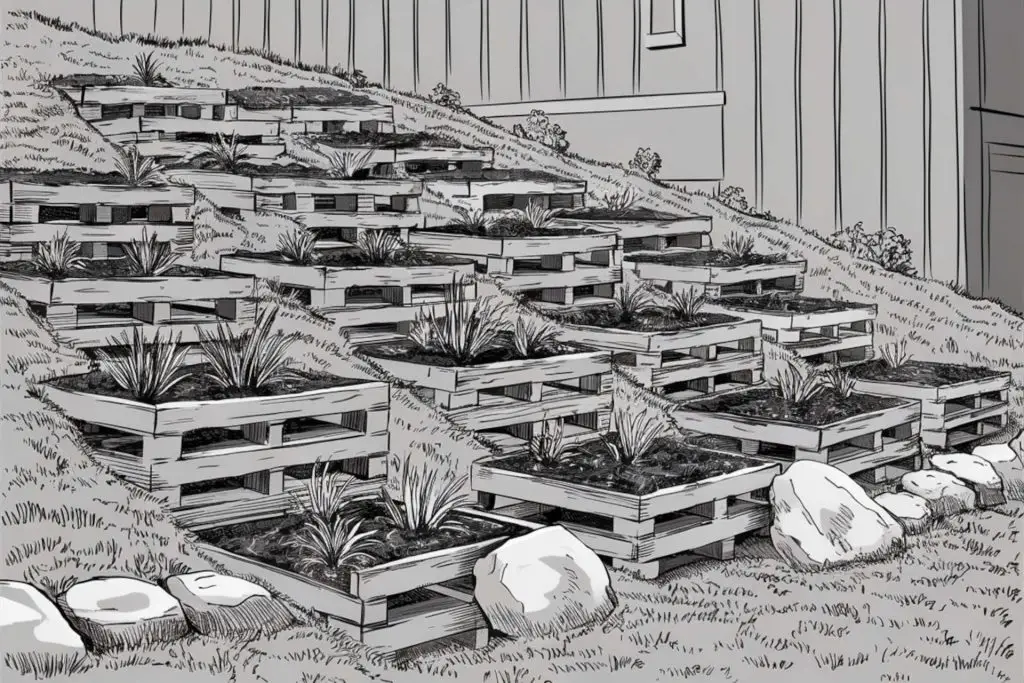
With your pile of prepped pallets ready, if you haven’t already, it’s time to think about the layout of the slope! But before grabbing your hammer, there are a few factors that need to be considered.
Understanding Your Slope:
First things first – assess your slope. Is it a gentle incline or a near-vertical cliffhanger? Knowing the angle will help determine the best approach. Additionally, take a peek at your soil. Is it sandy, clay-rich, or something in between? Understanding the soil composition helps you choose the right techniques for stability and drainage.
How Are You Going to Deploy the Pallets
picking your design! Here are a few popular options for sloped gardens:
- Retaining Walls: For steeper slopes, creating tiered retaining walls with pallets is a fantastic choice. These walls hold back the soil and create level planting areas.
- Terraces: Similar to retaining walls, terraces offer a series of leveled platforms perfect for planting a variety of flowers and vegetables.
- Raised Beds: Even on moderate slopes, raised beds made from pallets can add definition and create pockets of rich planting soil.
Drainage is Key:
No matter your chosen design, proper drainage is crucial. Stagnant water can damage your plants and weaken the pallets. Here are some tips:
- Spacing: Leave some space between the pallet boards to allow water to seep through.
- Liner for raised beds: Consider lining raised beds with landscape fabric to allow drainage while preventing soil loss.
- French Drains (optional): For steeper slopes or heavy clay soil, consider installing a French drain to channel excess water away from your pallet structures.
Adding Accessibility:
Don’t forget about navigating your garden! If your slope is significant, steps and pathways will make your garden more accessible and enjoyable. These can be made from other materials such as brick, natural stone, concrete or decking.
Preparing Your Slope
Having already considered the gradient of the slope and decided on a layout and the number of pallets required, before proceeding to install the pallets, proper preparation of the slope is essential to create soil stability and promote healthy plant growth.
Clearing the Area: Remove any debris, rocks, and unwanted vegetation. This step is crucial to prevent any materials from interfering with the installation process and plant growth.
Soil Testing: Conduct a soil test to understand its composition and pH level. This information is vital for selecting the right plants and amendments needed to improve soil health.
Terracing the Slope: If the slope is very steep, consider creating terraces using the pallets to manage erosion and make planting easier. Terracing involves cutting into the slope to create flat areas, which are then held in place by the pallets.
Improving Drainage: Ensure good drainage to prevent water from pooling and destabilizing the slope. This might involve digging drainage channels or incorporating gravel at the base of the pallets to facilitate water flow.
Adding Soil Amendments: Based on the soil test results, enrich the soil with the necessary amendments. Organic matter, like compost or well-rotted manure, can improve soil structure, nutrient content, and water retention.
Installing an Irrigation System Mighy Be a Wise Choice
Although, for smaller sloped gardens hand-watering is eminently possible, installing an irrigation system, particularly if you have a large slope, offers several advantages that can save you time, water, and potentially even money in the long run. Here’s why an irrigation system can be a wise choice for your sloped pallet paradise:
- Consistent Moisture Delivery: Especially on slopes, achieving even watering with a hose can be challenging. Reaching all areas, particularly higher sections, can be difficult. An irrigation system ensures consistent water distribution throughout your pallet structures, reaching even the most elevated plants.
- Combating Erosion: Overwatering with a hose can lead to runoff and soil erosion, especially on slopes. An irrigation system delivers a controlled amount of water directly to the root zone, minimizing the risk of erosion and wasted water.
- Water Conservation: Precise watering with an irrigation system helps prevent overwatering, which is not only wasteful but can also damage your plants. This translates to lower water bills and a more environmentally friendly approach to gardening.
- Time-Saving Convenience: Imagine enjoying a relaxing weekend instead of battling the hose on your slope. An irrigation system takes the guesswork out of watering and frees up your time for other activities.
- Targeted Watering: Some irrigation systems allow for customization, letting you target specific areas within your pallet structures. This is particularly beneficial for plants with varying water needs.
It is true the upfront cost of installing an irrigation system might seem like, or may actually be a deterrent, the long-term benefits in terms of water conservation, plant health, and time saved can make it a worthwhile.
Securing the Pallets
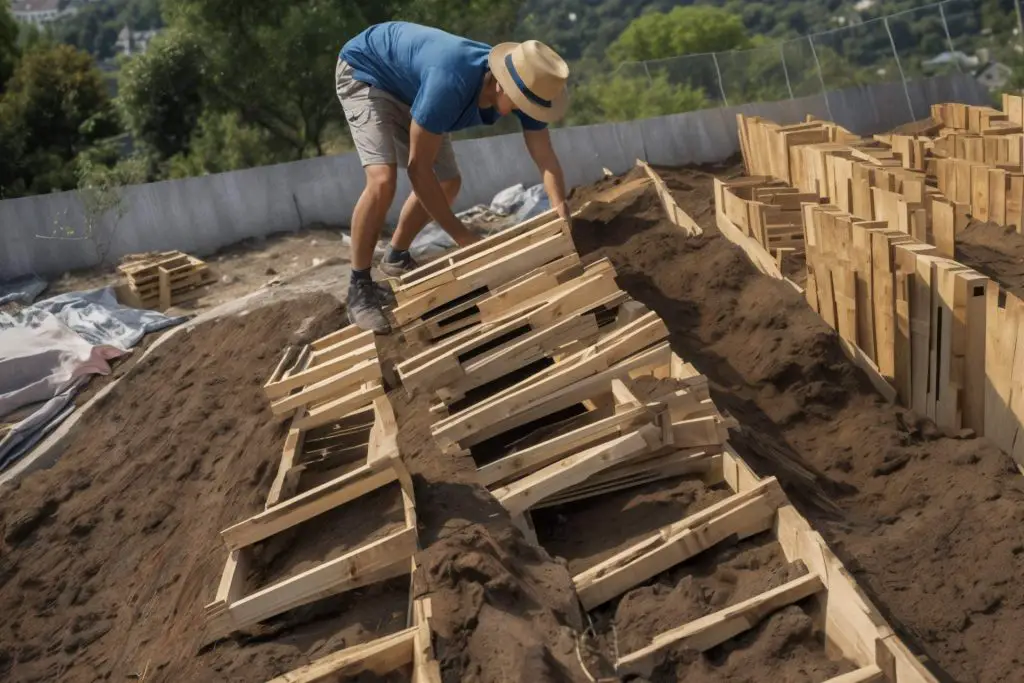
Thankfully, you don’t need to be a master carpenter to create sturdy and functional pallet structures. With a little know-how and the right tools, it is fairly easy to install the wooden wooden pallets into garden.
Tools Required
Before diving in, gather your tools: hammer, drill, screws, level, and a saw (optional, depending on your design).
Stability is King
The key to a successful pallet project is stability. Here are some techniques to ensure your creation withstands the elements:
- Stacking Strong: When stacking pallets, alternate the direction of the boards between each layer for a more robust structure.
- Screwing for Success: Secure the pallets together using heavy-duty screws. Don’t skimp here – proper connections are essential!
- Staking it Down: For steeper slopes or retaining walls, consider driving metal rebar stakes into the ground behind the pallets and securing them with zip ties or wire for added reinforcement.
Level Up Your Garden
Use a level to ensure your pallet structures are straight and even. This is especially important for retaining walls and raised beds to prevent leaning or collapse.
Stability Secrets
- Interlocking: When stacking pallets, offset them so the corners overlap, creating a stronger, more stable structure.
- Bracing: Add diagonal braces to the back of retaining walls for additional support, especially on taller structures.
- Shims: Place wooden shims under pallets to adjust their height and create a level surface.
Anchoring Down
Even if you don’t have a particularly steep slope it is advisable, for additional stability, especially in loose soil, you can anchor your pallet structures to the ground. Drive rebar or heavy-duty stakes into the ground in front of the pallets and screw or attach with them with wire directly to the pallet wood.
Backfilling with Soil
Once all pallets are securely in place, backfill them with soil. Use a high-quality topsoil mixed with compost to promote plant health. Ensure the soil is packed tightly to avoid settling or erosion later on.
Water Drainage Management
Implement drainage solutions to prevent water accumulation, which could lead to soil erosion or pallet decay. Consider installing French drains or gravel trenches along the uphill side of the pallet structure.
Erosion Control
Additionally, depending on your soil it is worth considering erosion control to prevent soil erosion behind your pallet structures. On option is to consider laying down landscaping fabric. This breathable material allows water to drain while minimizing soil washout.
Plant Selection
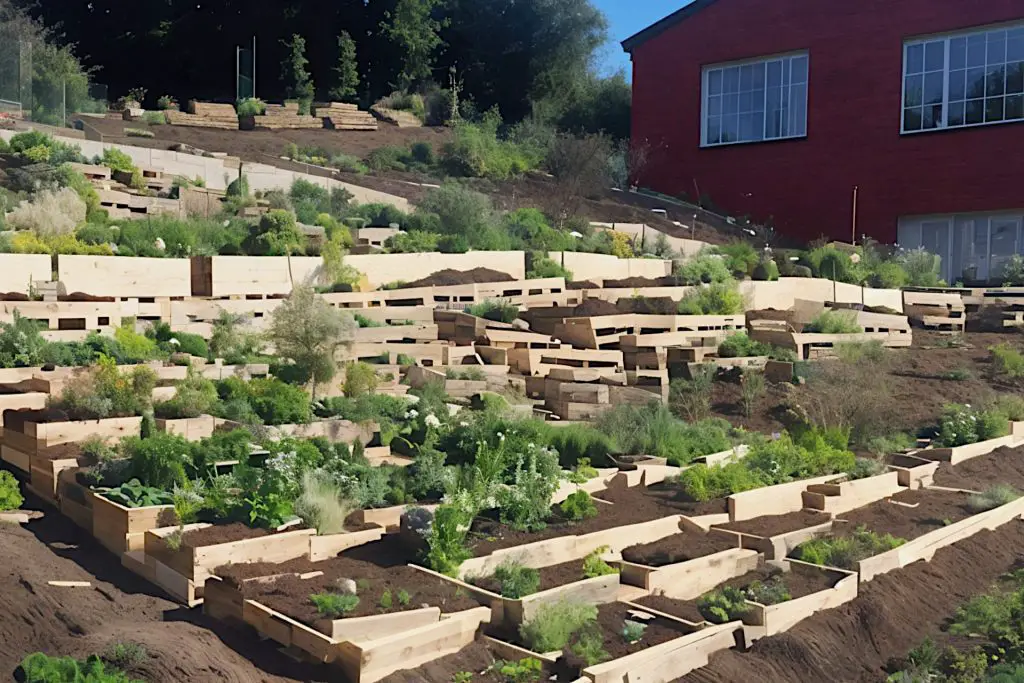
Picking the right plants for your sloped garden involves understanding the microclimate and soil conditions. Start by selecting deep-rooted plants that can help stabilize the slope, reducing erosion and providing structural support.
Native Plants: It is generally best to go for native species that are well-adapted to your area’s climate and soil. Native plants typically require less maintenance and are more resilient to local pests and diseases. Examples include creeping phlox, juniper, and native grasses, which are known for their erosion control capabilities.
Ground Covers: Low-growing ground covers like creeping thyme or sedum can quickly cover exposed soil, helping to reduce erosion. These plants spread easily, require minimal maintenance, and can thrive in poor soil.
Perennials and Shrubs: Select perennials and shrubs that can provide year-round interest and stability. Perennial herbs, such as lavender and sage, are not only durable but also attract pollinators. Shrubs like cotoneaster and forsythia offer additional root mass, which helps to hold the soil in place.
Vegetables and Herbs: If parts of your slope receive ample sunlight, consider planting vegetables and herbs. These can include resilient varieties like squash, which can cover large areas, or herbs that can double as ground covers, such as oregano.
Moisture and Sunlight Needs: Group plants with similar watering and sunlight needs to simplify care and enhance survival rates. For example, drought-tolerant plants should be placed in areas prone to drying out, while moisture-loving plants can be located in spots where water accumulates.
Beyond the Basics
When planning your plant layout, consider the accessibility for maintenance and harvesting. Ensure that frequently used paths are lined with plants that are easy to trim and do not obstruct movement.
Planting for Effect
Think beyond just functionality! Use a variety of plant heights, textures, and colors to create a visually stunning garden. Consider incorporating flowering plants for bursts of color, ornamental grasses for added texture, and trailing vines such as creeping boobialla to cover the pallets and soften edges.
You don’t have to limit yourself to just groundcovers! Depending on your slope’s angle and available space, you can incorporate bushes and small trees to break-up the landscape. Choose drought-tolerant varieties for sunny slopes and shade-loving options for those with less sun exposure.
Beyond the Build: Additional Considerations
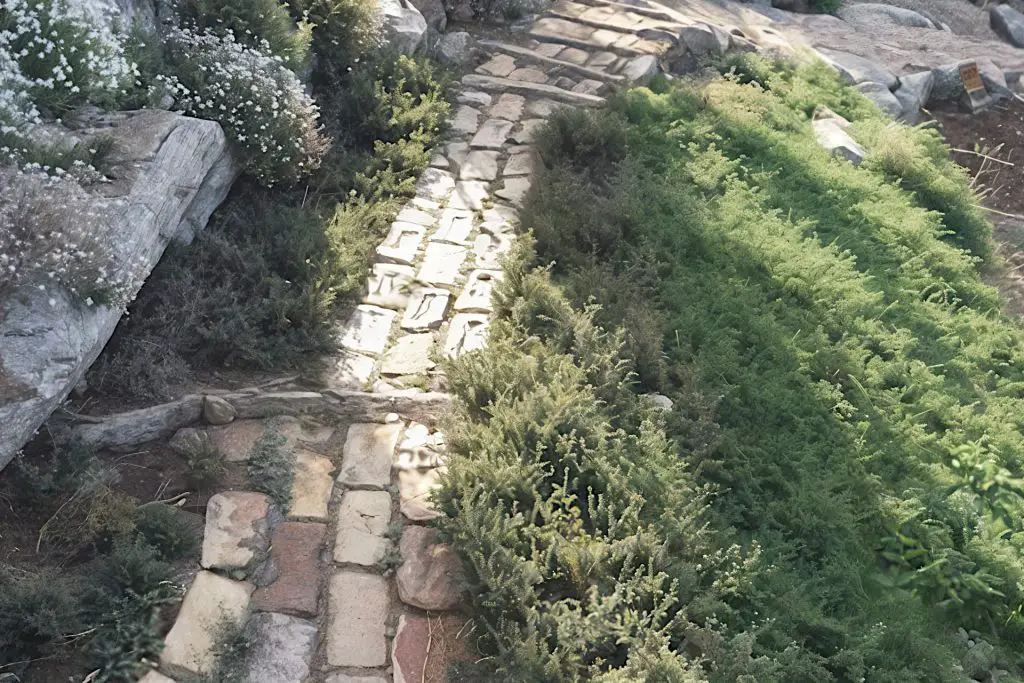
We’ve covered a lot of ground (pun intended) when it comes to building and planting your sloped pallet paradise. But before you grab your hammer and head outside, let’s explore some additional considerations to ensure a safe and successful project.
Safety First
Safety should always be a priority. Here are some tips to keep in mind:
- Wear proper gear: Sturdy shoes, gloves, and eye protection are essential when working with tools and wood.
- Lifting with care: Don’t attempt to lift heavy pallets alone. Recruit a friend or use proper lifting techniques to avoid injury.
- Be mindful of slopes: Steeper slopes require extra caution. Consider using a ladder or scaffolding for stability when working at heights.
Cost Comparison
While pallets offer a budget-friendly option, it’s helpful to consider the overall cost of your project. Here’s a breakdown:
- Pallet sourcing: Free or low-cost pallets are often readily available, but factor in any transportation costs.
- Hardware: Screws, nails, and other hardware will add to the overall cost.
- Optional extras: Landscape fabric, drip irrigation systems, and additional soil amendments will add to the cost but can improve functionality and longevity.
Environmental Considerations and Benefits
Integrating environmental considerations into your slope stabilization project not only benefits your garden but also contributes to broader ecological health. Here’s how to ensure your project is environmentally friendly and beneficial:
Sustainable Materials
Using recycled pallets not only reduces waste but also minimizes the demand for new lumber. Ensure that the pallets are sourced responsibly and are free from harmful treatments. This approach supports waste reduction and promotes the reuse of materials.
Water Conservation
Design your garden to maximize water efficiency. Use drought-resistant plants and effective mulching techniques to reduce water usage. Implementing a drip irrigation system can direct water precisely where it’s needed, minimizing waste and runoff.
Soil Health
Maintaining healthy soil is crucial for preventing erosion and supporting plant health. Use organic matter to enrich the soil, avoid chemical fertilizers, and opt for natural pest control methods. This enhances the soil’s structure and fertility without the adverse impacts of chemical inputs.
Biodiversity
Choose a variety of plants that provide habitats and food sources for local wildlife. Incorporating native plants enhances biodiversity by supporting local insects, birds, and other wildlife. This diversity can help maintain ecological balance and promote a healthier garden environment.
Carbon Footprint
By using local materials and native plants, you can reduce the carbon footprint of transporting goods. Additionally, the plants themselves help sequester carbon dioxide, contributing to carbon reduction in the atmosphere.
Reducing Heat Islands
Plant coverage on slopes can help reduce the heat island effect in urban areas. Vegetation naturally cools the air through the process of transpiration, leading to a cooler local climate.
Erosion Control
Properly stabilized slopes prevent soil erosion, which can protect water quality in nearby streams and rivers by preventing sediment runoff. This also protects local aquatic habitats and maintains cleaner water bodies.
Aesthetic Value
Environmentally considerate landscaping enhances aesthetic value and can increase property values. A well-maintained slope with diverse plant life not only looks beautiful but also demonstrates a commitment to sustainable living practices.
Educational Opportunity
Your garden can serve as a model for sustainable gardening practices, educating neighbors and visitors about the benefits of environmentally friendly landscaping techniques.
